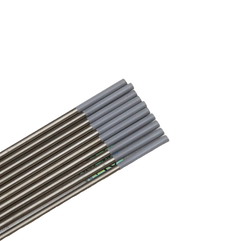TIG welding is known for its precision and ability to produce clean welds across various materials, including aluminum and stainless steel. A crucial component of this process is the tungsten electrode, which significantly influences both arc stability and weld quality. However, some alloying oxides used in these electrodes can pose risks. Welders must be aware of these dangers to protect their health.

Types of Tungsten Electrodes and Their Risks
TIG electrodes come in several compositions: pure tungsten, thoriated, ceriated, lanthanated, and zirconiated variants. Thoriated tungsten is among the most commonly used due to its superior performance, especially in DC welding applications. However, it poses significant health hazards.
Thoriated Tungsten: The Radioactive Risk
Thoriated tungsten electrodes contain thorium dioxide (ThO₂), a radioactive compound that enhances electron emission and arc stability. While the radiation emitted from these electrodes is low, there are concerns about the dust created during grinding and preparation. Inhaling thorium-laden dust can expose welders to long-term health risks.
Risks Associated with Thoriated Tungsten
1. Radiation Exposure
Alpha Radiation: Thorium emits low-level alpha radiation, which is generally safe. However, it becomes harmful if ingested or inhaled.
Beta & Gamma Radiation: These types emit minimal levels but can still add to long-term exposure risks.
2. Inhalation of Thorium Dust
Grinding or sharpening thoriated tungsten electrodes generates fine thorium dust. If inhaled, this dust can accumulate in the lungs, increasing the risk of lung cancer and other health issues.
Poor ventilation or inadequate personal protective equipment (PPE), like respirators, heightens this risk.
3. Environmental Concerns
Thorium is classified as radioactive waste. Improper disposal of thoriated tungsten electrodes can lead to contamination.
Many regulations require special disposal methods for materials containing thoriated tungsten.
4. Regulatory & Workplace Safety Issues
Health and safety organisations have established limits on the use and disposal of thoriated tungsten due to its radioactive properties.
Many companies are transitioning to safer alternatives, such as lanthanated, ceriated, and E3 rare earth tungsten electrodes.
Mitigating Risks
To minimize the dangers posed by thoriated tungsten, consider the following:
Always use a dedicated tungsten grinder equipped with an efficient dust extraction system.
Wear appropriate respiratory protection, such as a P3-rated mask.
Store and handle thoriated tungsten carefully, adhering to manufacturer and regulatory guidelines.
Alternatives to Thoriated Tungsten
In light of health concerns related to thorium, many welders are choosing safer alternatives, including:
Ceriated Tungsten: Ideal for low-amperage applications and suitable for both AC and DC welding.
Lanthanated Tungsten: Provides excellent arc stability and longevity, comparable to thoriated tungsten but without radioactive risks.
Zirconiated Tungsten: Primarily used in AC welding, especially with aluminum, as it offers a stable arc and resists contamination.
E3 Rare Earth Tungsten: A non-radioactive alternative that boasts excellent ignition properties, arc stability, and longevity, making it versatile for both AC and DC applications.
These alternatives significantly reduce health risks while ensuring high welding performance. Thus, they can effectively replace thoriated tungsten. At Truflame, we recommend switching to alternative tungsten options. You can see more here.
Handling and Disposal of TIG Tungstens
All tungsten electrodes must be handled with care. Follow these best practices:
Grinding: Use a dedicated tungsten grinder to prevent cross-contamination and reduce airborne particles.
Storage: Keep electrodes in their original packaging or a sealed container to minimize contamination risks.
Disposal: Thoriated tungsten must be disposed of as hazardous waste to keep it out of general waste streams.
TIG welding is a precise and efficient process, but understanding the dangers of tungsten electrodes—especially thoriated ones—is essential for safety. With this knowledge, welders can ensure a safe working environment while opting for safer alternatives and following proper handling procedures.
Recommended Tungstens for Your Application
For DC Welding: The ideal choices are ceriated, lanthanated, and E3 rare earth tungstens. Both lanthanated and E3 are popular due to their non-radioactive nature and excellent performance.
For AC Welding: Zirconiated tungsten is often preferred for its stable arc, despite having a relatively lower current capacity.
Switching to safer electrodes can ensure better welding practices while maintaining outstanding results.
At Truflame, we prioritise safety and efficiency. We offer expert advice and high-quality welding supplies to meet your needs. If you're searching for the best TIG tungsten for your applications, explore our range today or contact our team for guidance.









Comentarios